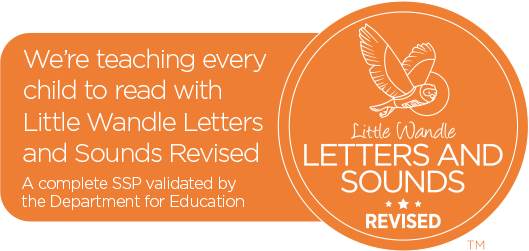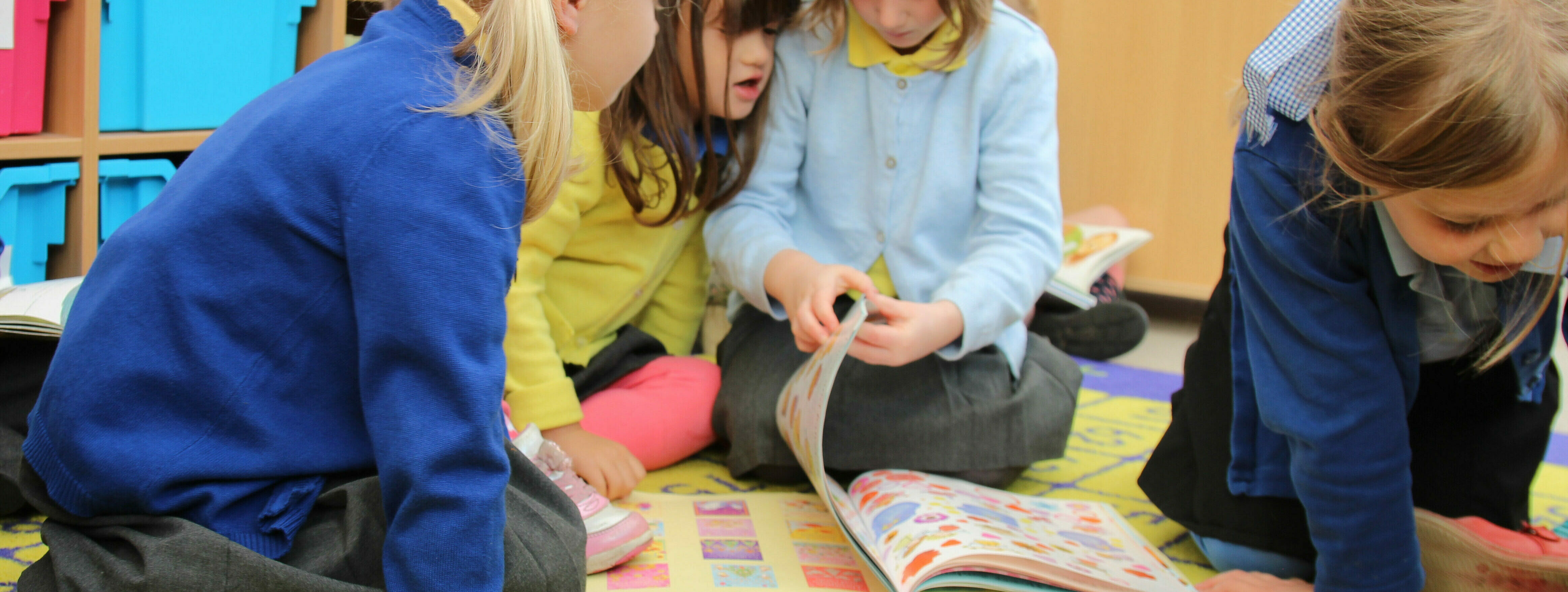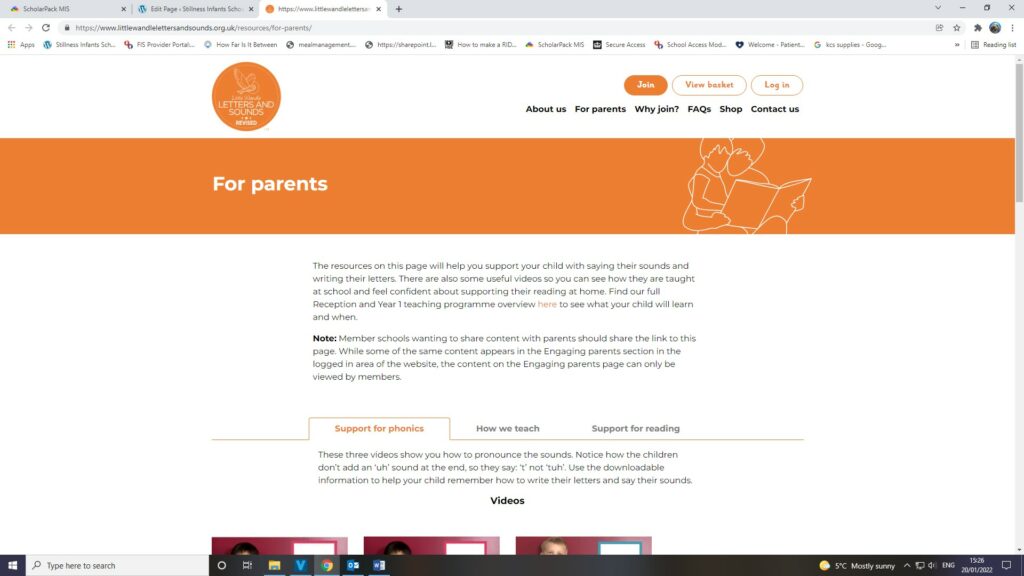Reading And Phonics
Reading and Phonics at Stillness Infants

At Stillness Infants, we value reading as a key life skill, and are dedicated to enabling our pupils to become lifelong readers.
By the time children leave Stillness Infants they are competent readers who genuinely enjoy reading. They have a range of comprehension skills, can recommend books to their peers, and enjoy discussions about books.
We firmly believe that reading is the key to all learning and so the impact of our reading curriculum goes beyond the results of the statutory assessments in KS1. We give all children the opportunity to enter the magical worlds that books open up to them. Reading for pleasure is the foundation for which our curriculum is based on.
We believe that phonics provides the foundation of learning to make the progress development into fluent reading and writing. At our school, we use Little Wandle Letters and Sounds Revised to provide daily, engaging phonics lessons.
Their website is full of fantastic resources and advice for parents:
Phonics is the process that is used to help children break down words into sounds, as well as building letter and word recognition. This equips children with a strategy to read unfamiliar words in the future. Children learn to blend sounds to read words and then segment words to support their writing and spelling ability.
Please click on the link below for our Phonics and Early Reading Policy:
Phonics and Early Reading Policy
We believe reading is key for academic success and so to ensure we have a holistic approach to the teaching of reading, we implement the following:
- Children take part in one to one reading sessions with their class teachers and teaching assistants twice a week, where children are exposed to a range of different texts, matched to their level. They can demonstrate their understanding and thinking behind these through conversations based on comprehension. This is a chance for teachers and teaching assistants to set targets for individual children, and will also inform intervention groups.
- Higher attaining readers are stretched to respond to their reading with writing and drawing, giving opinions and making deductions. All children have access to series of chapter books, kept up to date with the latest titles.
- Children have daily phonics sessions in class where they participate in speaking, listening and spelling activities that are matched to their developing needs. The teachers draw upon observations and continuous assessment to ensure children are stretched and challenged and to identify children who may need additional support. Children work through the phonics programme below, learning and developing their phonics sounds and knowledge.
Please click on this link for our overviews which will show you the programme of phonics learning for each term in Reception and Year One:
Reception Phonics Programme Overview
This link will support you in using the correct pronunciation for each phoneme and the corresponding graphemes:
Little Wandle Letters and Sounds
- Kim McArthur is a full-time staff member that runs additional phonics groups in Reception, Y1 and Y2. She does regular and rigorous phonic assessments, on a half termly basis, in Reception and Y1 to identify those recognising below 80% of the sounds taught so far. This assessment will inform the composition of the intervention groups. She also incorporates some precision teaching 1:1 for the Y2 children that did not pass the phonics screening check in Y1.
- Additional reading sessions support disadvantaged children and those with educational needs. This is highlighted in provision maps by each teacher for each individual class. These groups are targeted through interventions, be that the precision teaching of phonics, or additional reading comprehension groups.
- Shared Reading happens in every classroom three times a week. The books that are shared usually link to the topic or the writing style that is being focused on that week. It teaches children key reading skills: fluency, decoding, prosody, comprehension and vocabulary.
- All children from Nursery to Year 2 choose reading books to take home and these books are changed weekly. One book will be matched to their level whilst the other is called “free choice” and is chosen by the child to read at home with their families.
- Each classroom has a selection of books which are directly linked with the class topic. This offers opportunities for the children to apply their reading skills across the curriculum, exposing them to useful vocabulary that they will be able to apply to other areas of their learning.
- Children are read to each day by their class teacher. This could be a book that the teacher recommends to the class or a recommendation from a child.
- Teachers create class “Big Books” which are books full of creative comprehension activities that create a love and enjoyment of reading.
- Each classroom has a reading area that is filled with books suitable for their reading age. This is a comfortable place for children to read throughout the day.
- We expect families at home to read books with their child daily and make comments in their child’s reading record. There will be comments on your child’s progress in reading form the Class Teacher and TA. The importance of reading with children is encouraged when parents are invited to school curriculum meetings and parent consultations. Teachers will engage with parents through reading records to encourage them to read at home.
- “Author of the month” changes each month. A display is updated with a variety of the specific author books and there is always an assembly to introduce them. Teachers and children are able to access the display in the school and pick from the books available to read in class time.
- Author visits happen a few times a year. They will give an assembly to the children and offer a meet and greet whilst signing copies of the book’s children have bought.
- In EYFS a “secret reader” (a parent) is brought into the classrooms to read to the children.
- World Book Day is celebrated every March. Children are encouraged to dress up as a character and the day’s activities are focused around reading. We run a book swap where children and adults bring in a book they have finished with and swap if for a new one.
- Book Fairs take place during the year. Children are encouraged to take a look at the selection on offer and make a purchase with their parents. We promote Crofton Park Library and many children take part in their summer reading scheme as well as borrowing books throughout the year.
- Teachers are given regular English CPD sessions where reading and phonics will be covered. In this time teachers will be provided with new tools and exciting ways for the reading curriculum to be progressed.
- Teaching Assistants have had training in reading and phonics.
- Kim McArthur offers additional training to parents and staff who wish to improve their phonics teaching. She has a wealth of knowledge and resources on offer.
Through the teaching of systematic phonics, our aim is for children to become fluent readers by the end of Key Stage One. This way, children can focus on developing their fluency and comprehension as they move through to Junior School.
Initially, teachers evaluate each lesson and plan the children’s next steps. This evaluation is used in regular pupil progress meetings which can be used to support intervention programmes seen in class provision maps. Senior Leaders monitor the impact of the curriculum, celebrating the children’s achievements in all subjects and working together to plan activities and events to support the children’s learning. The English Curriculum Leader monitor the subject throughout the year to reflect the current demands of the curriculum and to inform future planning. Our school improvement plan is what drives areas for development. It is drawn up and agreed in an annual meeting with all staff and governors when the years achievements are celebrated, and next steps are planned.
Attainment in reading is also measured using the statutory assessments at the end of Key Stage One. These results are measured against the reading attainment of children nationally. Attainment in phonics is measured by the Phonics Screening Check at the end of Year 1.


